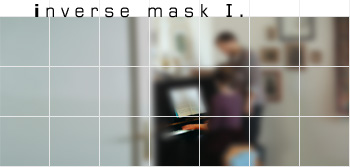Inverse mask I.
computer installation; 2002
What the visitor sees is an obscure picture. It can only be presumed what it might depict. There is a small moveable spot in the picture that gradually becomes sharper and sharper. If we try to move this spot too quickly, it simply disappears and we can only see the oblique picture. To explore all the of details of the picture and gain complete illusion (grand illusion) of it, one has to contemplate over the picture slowly and thoroughly.
The main concept of my work is strongly bound to the philosophy of vision. The human eye can sharply focus only on a small part of the picture; the rest of it remains obscure. By moving this focus rapidly all over this picture we scan all the details of it, but it is the brain that composes the whole image. There are always fragments that remain unscanned, still we don't have the feeling of not seeing well. Using a kind of error correcting algorithm our brain recovers the missing parts.
The acceleration of perception makes the error correcting algorithms more and more perfect. Less and less visual information becomes sufficient for composing an image. But this image, believed to be complete, is always less real, rather restored.
This inverse mask slows down the process of seeing and forces the spectator to focus and spend more time on details that he would otherwise omit. It shows us a slower and deeper way of seeing which, I think, is more appropriate when looking at pieces of art.
related:
download:
Video about the exhibition (imask1.avi, 3.62M)
The application (imask.exe, 2.07M)
exhibitions:
Zweite welt - Budapest 2004,
Ateliers Pro Arts
Inverse mask - Budapest, 2002,
C3 Gallery
Zweite welt - Berlin 2002,
Treptowers
